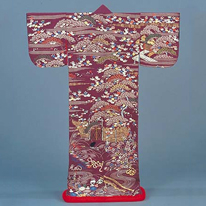Past Exhibitions
- Costumes of the Samurai Class
- June 24, 2016 - July 24, 2016
Beginning in the 1600s, when Shogun Tokugawa Ieyasu (1543–1616) established the Tokugawa shogunate, Japan entered a new age of stability. In the two-and-a-half centuries to follow, Japanese society settled into distinct classes of people—including aristocrats, warriors (samurai), and commoner townspeople—who were distinguishable by their clothing. The costumes that members of the warrior class wore at specific ceremonies and at different times of the year were governed by detailed and complex rules. This exhibition features primarily samurai women’s garments, including outer robes (uchikake) and kimono with intricate “imperial court” (goshodoki) designs often containing hidden literary symbolism. It also includes a few examples of male costume, namely the noshime robes with bands around the midsection. All of these robes would immediately have identified their wearers as members of the warrior class to their Edo period contemporaries.












